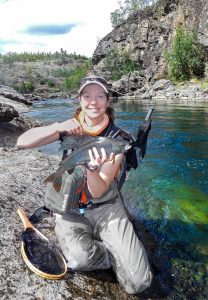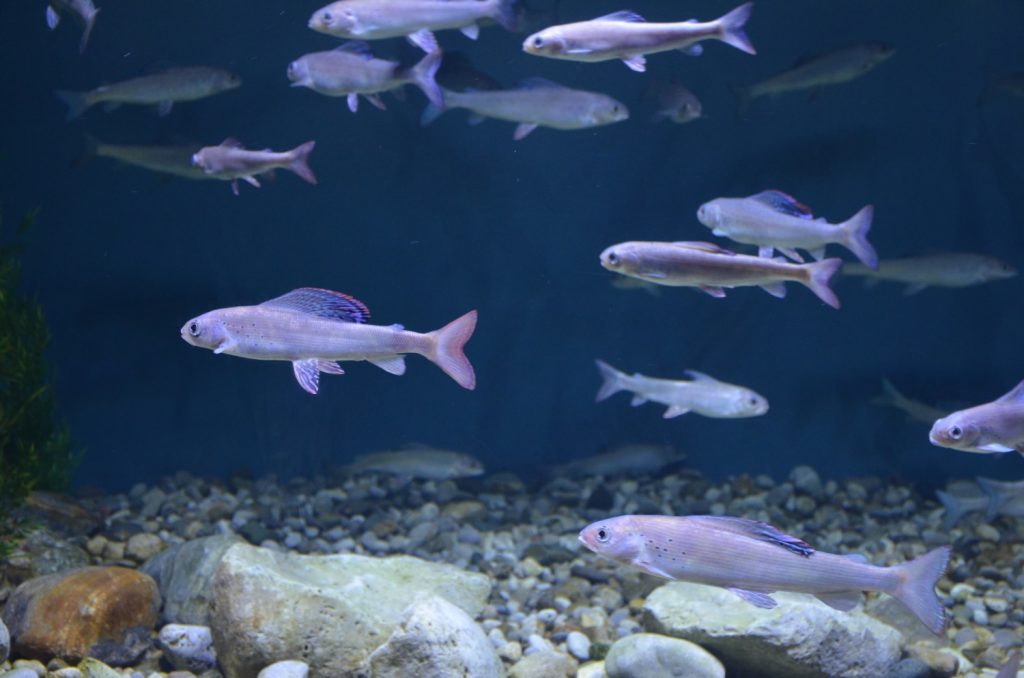Arctic Grayling: The Jewel of Canada’s Northern Waters
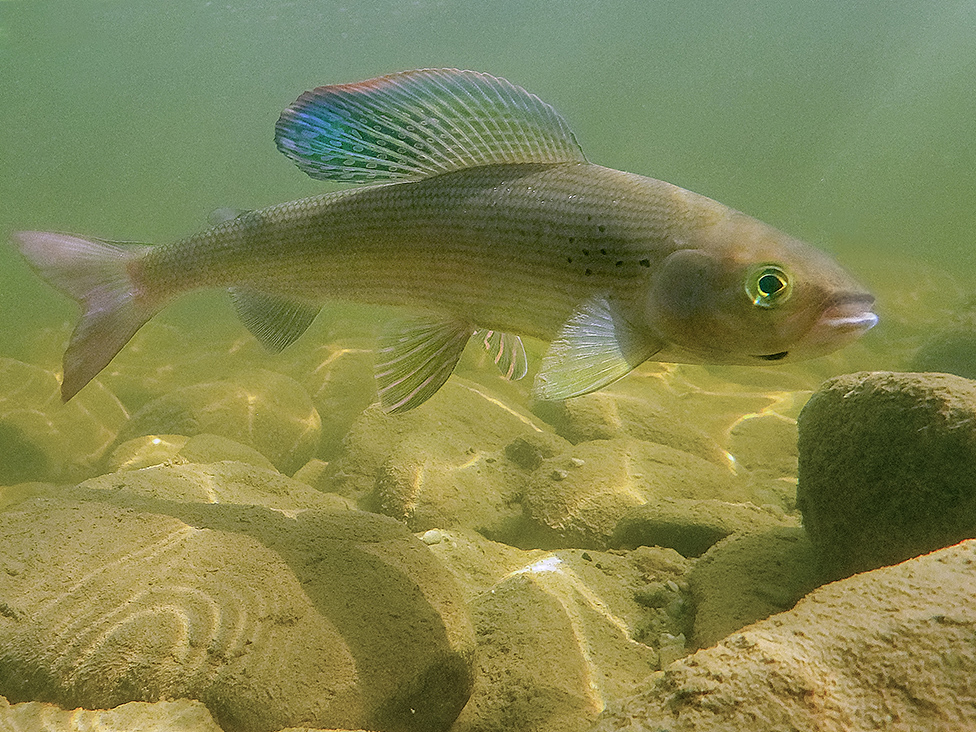
An Arctic grayling showing off its flashy dorsal fin. WALLY LUTZ
BY JESSICA REILLY
Some people quilt. Some make craft beer. I have a more unusual hobby. I spend my free time studying Arctic grayling, and it captures every ounce of my curiosity. Arctic grayling have striking colouration with large dorsal fins reminiscent of a marine sailfish. They are aggressive feeders and fun to catch on a fly. In studying them, we learn more about the ancient processes that led to the rich mosaic of biodiversity around us today.
Grayling Diversity
Much about the evolution and taxonomy of grayling remains uncertain. They are salmonids (close cousins of whitefish and trout) that first appeared as a distinct subgroup somewhere between 10 to 50 million years ago. Their place of origin remains uncertain; however, Eurasia is a likely candidate given the high diversity of grayling species found there. Today, there are between 13 and 18 species of grayling distributed across freshwater systems in the northern parts of North America, Europe, and Asia.
A distinctive feature of all grayling is their large, colourful dorsal fin. Among the various species you will find a riot of red and electric-blue spots, red stripes, and golden-yellow shading. One of the most striking species is the Upper Yenisei grayling, found near the Mongolian-Russian border. These fish are incredibly vibrant, featuring a dorsal fin with large, light-blue splotches and blood-red trim as well as a tail seemingly dipped into a pot of golden paint. Other species, particularly in pristine areas, are not only gorgeous but can obtain sizes that would shock Alberta anglers. Imagine landing a 70-cm Mongolian grayling after a lifetime of catching the typical 25- to 35-cm fish here at home!
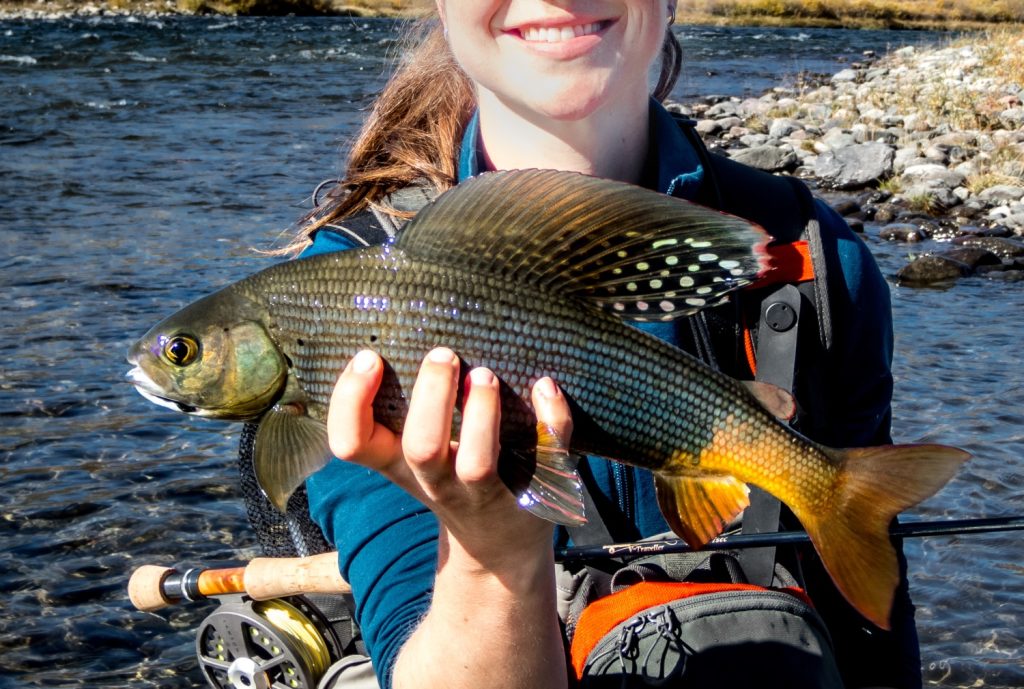
An Upper Yenisei grayling in Mongolia. These grayling have bright yellow tails and light blue spots on the dorsal fin. BLAIR REILLY
Journey to North America
If grayling arose in Eurasia, when and how did they make it over to North America? Their first appearance here was probably 3 to 5 million years ago, during the heyday of woolly mammoths and sabre-toothed tigers. During this period, sea levels were far lower than today because of a cool climate and the buildup of large ice sheets. So low, in fact, that the Bering land bridge formed between Alaska and Siberia, connecting the continents and providing a pathway for grayling from west to east. Since then, sea levels have risen and fallen numerous times, periodically recreating this terrestrial connection. This has led to multiple exchanges of Arctic grayling, with evidence suggesting that the last exchange occurred around 500,000 to 900,000 years ago.
After arriving in North America, Arctic grayling had to achieve another remarkable feat: survival. The northern portion of our continent is a harsh place to call home. Massive ice sheets have grown and receded many times, constantly reshaping the distribution of animals and plants. Today, Arctic grayling are found from Alaska to Hudson Bay and as far south as the Athabasca River watershed in Alberta, with an isolated population in Montana.

The approximate current range of native Arctic grayling in Canada and Alaska (in blue). A small disjunct population also exists in Montana. The location of the Caribou Mountains is outlined in red.
Today’s distribution represents only a small snapshot of the grayling’s history. Turn back the clock and you would see the range of Arctic grayling expanding and contracting, mirroring the available habitat through the many glacial and interglacial periods. The details of these range shifts are murky, but a 200,000-year-old fossil found in Indiana confirms that Arctic grayling once lived much farther south than today. Fossil evidence from Alberta indicates that Arctic grayling once lived just south of Calgary, approximately 22,000 to 50,000 years ago. For some reason, perhaps the re-expansion of ice sheets, these grayling died out.
The Colonization of Alberta
Today, we are living in a relatively warm interglacial period. However, the distribution of wild species still bears the stamp of the most recent glacial period. From around 75,000 to 11,000 years ago, most of Canada was inaccessible for Arctic grayling. So where did they survive the deep freeze? A logical theory is that they persisted in southern, ice-free rivers and lakes in what is now the mid-central United States and then later colonized northward. However, there is now strong fossil, genetic, and geological evidence that small pockets of suitable habitat persisted in the north and provided a safe haven.
For Arctic grayling, one of these refuges is called Beringia, located in modern-day Alaska. As the climate warmed and ice retreated, Arctic grayling dispersed from Beringia back into the Yukon River and then down into the Peace River. They also moved along the Arctic coastline and from there into southeastern inland waters. A relatively new discovery is that Arctic grayling also survived in a refuge located in the Nahanni River valley. Descendants from these Nahanni fish went on to colonize the Liard, Hay, and Peace Rivers. Alberta is a contact zone for grayling originating from both sites, although the majority of fish are of Beringian descent.
Growing up near Edmonton, I was always curious about why the Arctic grayling range stopped at the Athabasca River. To my eye, the habitat in the North Saskatchewan River headwaters looked suitable and there seemed to be plenty of bugs to eat. Now, with an understanding of the long history underlying the grayling’s distribution, I would bet that a post-glacial hydrologic highway leading to the North Saskatchewan River did not exist at the right time. Or perhaps grayling did make it to the North Saskatchewan River, but were eliminated through some natural event long ago, leaving no trace.
Adventures in Studying Morphology
Many questions about Arctic grayling remain to be answered. Remember those Nahanni and Beringia fish whose descendants eventually wandered into Alberta? It turns out they are genetically very distinct — they haven’t shared a common ancestor for roughly 2 to 3 million years. This means that a grayling caught in the Pembina River is more genetically similar to one in Siberia than to one caught in northern Alberta. More work is needed to understand if these fish differ in other ways. Do they look or behave differently? Do they have different roles in the ecosystem? Can they breed with each other? Are Nahanni grayling so distinct that they warrant being called a different species?
Powered by a shared passion for grayling, a team of anglers, academics, and biologists have begun to study the Nahanni and Beringia lineages, looking for differences in appearance. If notable differences exist, such as the shape of the dorsal fin or size of the mouth, it could indicate that these two groups have evolved distinct local adaptations, an important consideration in conservation programs.
To ensure the study was scientifically valid, we couldn’t just use snapshots from our cellphones. This type of research requires a very specific photography setup to make sure all the observed variation stems from the fish themselves, not from differences in how the photos were taken. We also needed to find grayling in high enough numbers to achieve a reasonable sample size. Fortunately, Beringia grayling live in fairly accessible rivers in central Alberta. A small legion of experienced anglers from the Northern Lights Fly Fishers Chapter of Trout Unlimited Canada volunteered for the project, schlepping hundreds of pounds of camera gear, buckets, bubblers, safety, and fishing equipment down many kilometres of river and catching grayling. Once caught, the grayling were carefully handled, anesthetized, photographed, and then released unharmed.
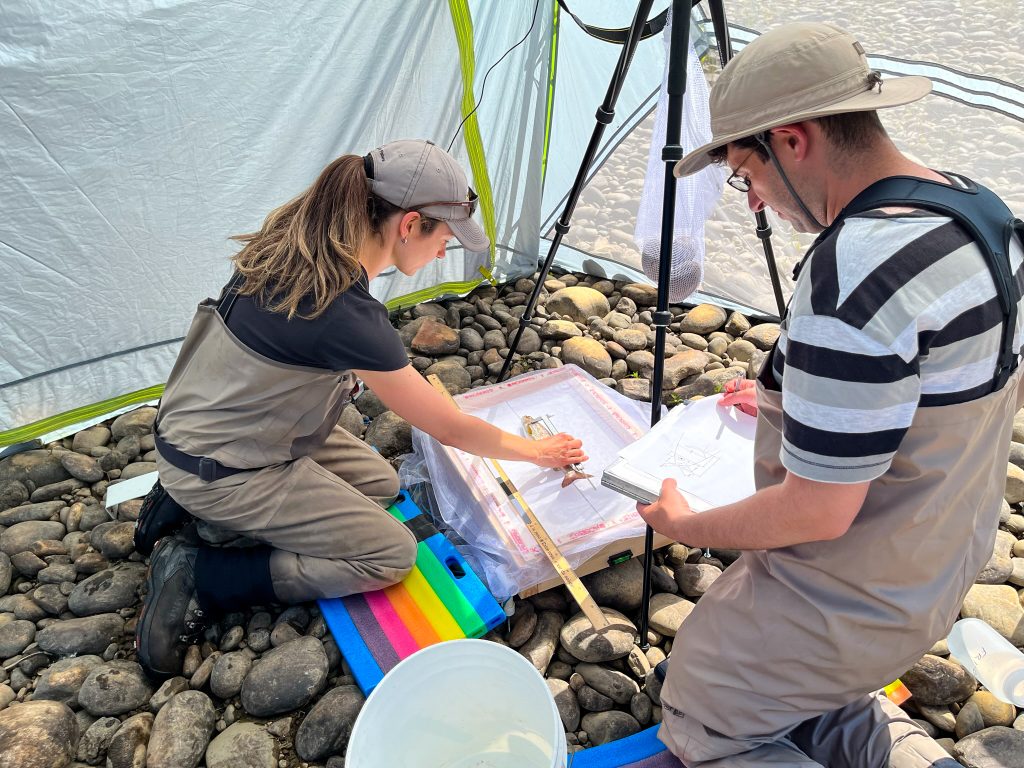
To identify differences among grayling lines, researchers use standardized data collection protocols and take high-quality photographs. KEN MONK
The true adventure was journeying to the Caribou Mountains in northern Alberta to repeat the procedure for Nahanni lineage fish (see map). There is exceedingly sparse information on fish populations from this part of the world, a sign of how inaccessible the area is, particularly in the summer. One of the rivers required a 150-km helicopter flight, with absolutely no roads or cutlines in sight.
After a 1000-km road trip from Calgary to High Level, the Nahanni lineage field crew and our mountain of photography equipment was finally on the helicopter tarmac, ready to go. From the air, the terrain was true boreal beauty, with black spruce forests, small pothole lakes rimmed with bright green plant life, and rivers so deeply tannin-stained that they looked like black tea. Over the next day and a half, we managed to catch and photograph all the grayling we needed, with only moderate (human) blood loss due to the raging mosquitoes. Our formal comparison will be complete by early 2024 and we will see if the Beringia and Nahanni lineages do indeed look different from one another.
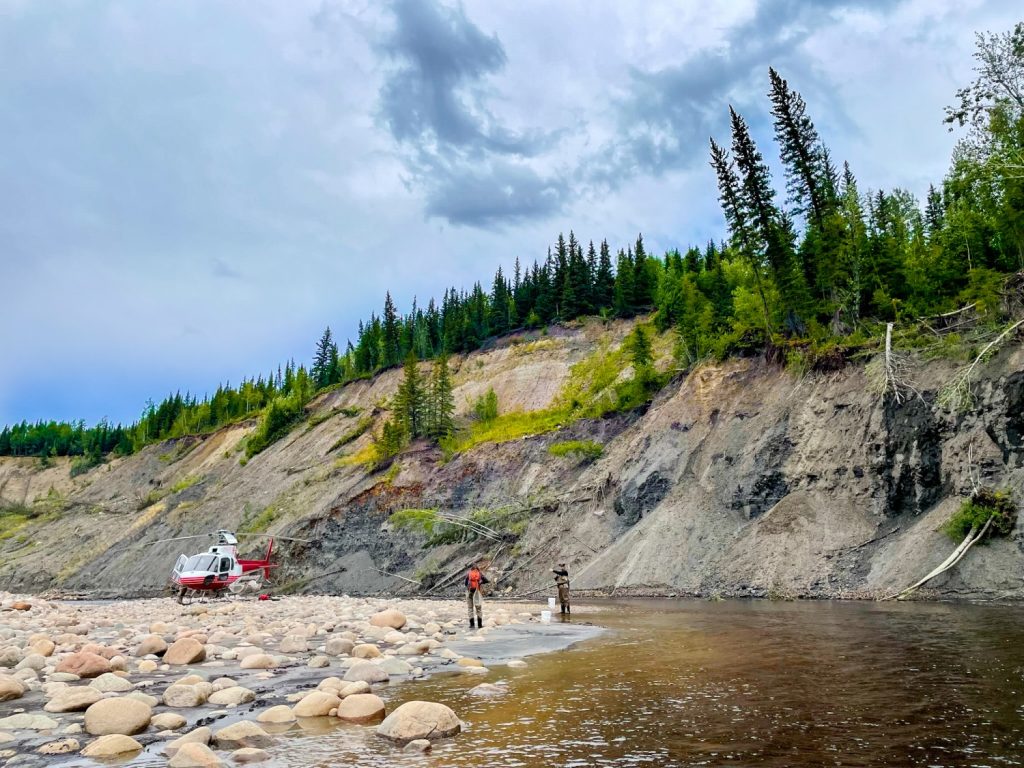
A tannin-stained river in the Caribou Mountains, home of the Nahanni-lineage Arctic grayling. KEN MONK
Arctic Grayling Conservation
Every grayling you see is the product of millions of years of evolution, luck, and survival. Unfortunately, their future in our province is not assured. Because of their sensitivity to changes in water temperature, sedimentation, habitat fragmentation, and vulnerability to angling, there is a chance we could lose these fish purely from human activity. In Alberta, their abundance has been reduced by up to 70% and they have been totally lost in 10 of 58 watersheds.
Arctic grayling are provincially listed as a Species of Special Concern, and several initiatives are underway to protect or restore populations. For example, sportfishing regulations for Arctic grayling became catch-and-release only across the province in 2014. Some fragmentation issues are also being addressed by replacing stream-roadway crossing structures to reconnect grayling habitat. There have also been extensive efforts in the Pembina River watershed by the Government of Alberta, the Northern Lights Fly Fishers, and other partners to recover the most southern population of native grayling in the province. It’s a great beginning, and by nurturing partnerships with angling clubs, Indigenous communities, industry, and conservation groups, together we can accomplish even more to keep these beautiful fish on our provincial landscape.
Jessica grew up in Alberta fishing along the Eastern Slopes with her dad. Today, she is a fisheries biologist specializing in conservation genetics and cumulative effects management and works as the Provincial Recovery Specialist for fish species at risk for the Government of Alberta.
Morphology research was supported by the Alberta Conservation Association, Alberta Environment and Parks, Grant MacEwan University, and Trout Unlimited Canada.
This article originally ran in Nature Alberta Magazine – Fall 2023.

